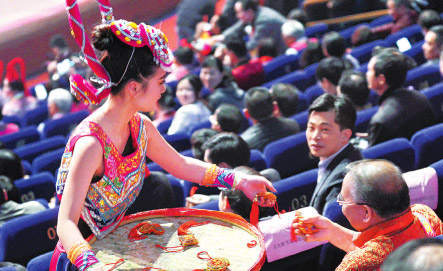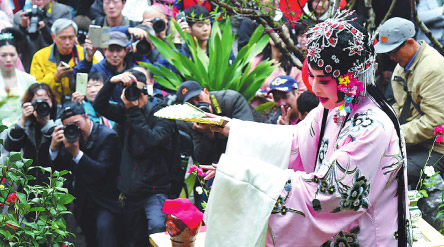Cultural ties draw B&R nations closer
Fujian province, a core area of the 21st Century Maritime Silk Road, has launched a range of overseas shows and art exhibitions in recent years to promote Chinese culture along the ancient trade route.
|
A clerk dressed in traditional She ethnic costume hands out scented sachets at an international forum in Fujian province.[Photo/China Daily] |
As part of its going out strategy for the local cultural industry, the province's efforts in developing its cultural resources started more than three decades ago, when President Xi Jinping worked in the province.
Xi paid the same amount of attention to cultural and people-to-people exchanges as he did to economic and trade cooperation, pushing forward the province's reform and opening-up when he held several positions there between 1985 and 2002, according to a report by Fujian Daily.
President Xi proposed the initiative of the Silk Road Economic Belt and the 21st Century Maritime Silk Road in 2013, marking the revival of the ancient trade route.
The Maritime Silk Road, which ran from China through Southeast Asia and the Indian Ocean to Europe, took shape in the Qin Dynasty (221-206 BC) and reached its peak during the Song (960-1279) and Yuan (1271-1368) dynasties.
|
An actress performs a local opera on stage. [Photo/China Daily] |
The province has launched a vast array of initiatives to establish and deepen cultural ties, such as building cultural exchange centers in countries along the Belt and Road routes to promote its time-honored culture.
Fujian's office for overseas Chinese affairs has launched summer camps in overseas schools to help children access and experience Chinese culture. Cities across the province have built sister-city relationships with 84 counterparts in 35 countries.
A dance drama, titled Dream of the Maritime Silk Road, has become a hit show symbolizing ancient East-West commercial and cultural exchanges.
Created by the Fujian Opera and Dance Drama Theater, the show tells the story of owners of a commercial fleet in Fujian's Quanzhou port developing a new sailing route with a Persian prince 800 years ago.
The show has been well received by audiences since it debuted in Beijing's National Center for the Performing Arts in 2014. It has been performed in more than 60 countries, regions and international organizations, including Malaysia and Indonesia, as well as the headquarters of the United Nations, UNESCO and the European Union. In Kuala Lumpur, Malaysia, a single session of the show drew more than 4,000 people, setting a new record.
Fujian has created a range of operas and performances featuring the ancient maritime trade route, including Sea Goddess Matsu, which was performed at the third Silk Road International Festival.
An exhibition featuring cultural relics relating to the Maritime Silk Road, starting in October 2013, won praise from domestic and overseas audiences. Staged by the Fujian Museum together with 51 museums around the country, the exhibition displays more than 240 relics that witnessed the development of the ancient trade route.
|
Foreign tourists dance at a park in Fuzhou, capital of Fujian province. [Photo/China Daily] |
Quanzhou origin
The maritime route, once used by legendary travelers such as Marco Polo and the Moroccan explorer Ibn Battuta, originated in Quanzhou, an international port at the time where different cultures met.
The third Maritime Silk Road International Arts Festival will be held in Quanzhou this December to celebrate and promote the city's involvement in the route since ancient times.
During the 12th Five-Year Plan (2011-2015) period, the city sent 130 delegations with a total of 2,108 members to participate in cultural exchanges and cooperation activities in 33 countries and regions, including Japan, South Korea, the United States and France.
In that period, more than 1,994 members of international cultural organizations from more than 40 countries and regions were invited to share their opinions on the local operas, cultural exhibitions and seminars.
The city's cultural products are exported to about 70 countries and regions around the world. In 2016, the added value of Quanzhou's cultural industry reached 30.4 billion yuan ($4.6 billion), up 10 percent year-on-year.


